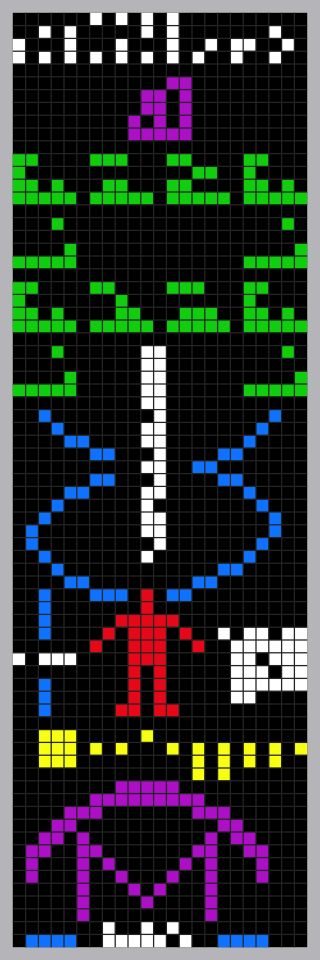Breakthrough Team Proposes Caution in Messaging Extraterrestrials
Carl Sagan had warned about making oblivious assumptions about exactly what’s out thereAt Universe Today, science writer Matt Williams tosses another hypothesis into the ring as to why we don’t see ET: Maybe, universally, everyone is listening but no one is broadcasting. Or few are, anyway. Now why might that be?
He outlines a distinction between two different approaches to the search for extraterrestrial intelligence (ET): SETI and METI
Most efforts to date have been SETI (Search for Extra-Terrestrial Intelligence) where we are looking for them. That encompasses projects like Cornell Astronomer Frank Drake’s pioneer Project Ozma (1960) and the current Allen Telescope Array.
More projects now, Williams says, are METI (Messaging Extra-Terrestrial Intelligence). We could include in that group the three-word Soviet Morse Message (“peace,” “Lenin,” and “SSSR,” radioed into space in Morse Code in 1962). Also the 1679-bit Arecibo Message sent from that telescope in Puerto Rico in 1974, aimed at star cluster M13, 21,000 light years away. Currently, there’s the Breakthrough Initiative, sponsored by Israeli-Russian billionaire Yuri Milner.
Relative to past METI projects, however, Breakthrough Initiative is very cautious: “To encourage global discussion on the ethical and philosophical issues of sending messages into space, we pledge not to transmit any message until there has been a wide-ranging debate at high levels of science and politics on the risks and rewards of contacting advanced civilizations.”
The caution might be in part because the METI approach has been criticized from the beginning for its presumption, notably by Carl Sagan (1934–1996). Sagan believed that we might actually get an answer. Remember, throughout his career, he had to conceal the extent to which he believed that we probably would get an answer because he feared pushback from more orthodox science authorities.
Russian radio engineer Alexander Zaitsev has long been a proponent of messaging, as he set forth in his 2006 paper (open access). It turns out, he has had ideological reasons for trying to directly message ETs. Williams tells us that Zaitsev believed, according to space physicist David Brin, in “a modified form of Universal Altruism (UA), a Soviet-era doctrine that states that all advanced civilizations naturally evolve towards the altruistic and socialistic.” As Brin puts it,

(Ironically Dr. Alexander Zaitsev has modified this doctrine to suggest that advanced aliens are not only altruistic but also cowardly — thus explaining their failure (so far) to create beacons or beam messages at Earth. He reasons that the youngest and most ignorant technological race (humanity) is behooved to overcome this universal cowardice by boldly announcing ourselves.
(This is not the place to analyze the logical faults of this assumption. I have a whack at it in a different article: Let me just offer one thought here. If aliens are so advanced and altruistic… and yet are choosing to remain silent… should we not consider following their example and doing likewise? At least for a little while? Is it possible that they are silent because they know something we don’t know?)
David Brin, “Shouting at the cosmos” at Lifeboat Foundation (2006)
So Brin (and the shadow of Carl Sagan) would advise caution.
Williams surveys various thoughts and criticisms on this rethink of the Fermi Paradox, beginning with the contestable assumption that extraterrestrial civilizations would have a uniform approach to the situation — or that we ourselves would:
Like many proposed resolutions to the Fermi Paradox, this hypothesis assumes that the behavior of extraterrestrial civilizations is uniform. Similar to the Dark Forest and Zoo Hypotheses, all that is required for the “Great Silence” to be broken is for one ETI to speak out. And given humanity’s own experiments with crafting interstellar messages, it is hard to believe that one civilization would be able to enforce a “radio silence” policy, let alone many.
In addition, if any civilization were to detect a signal from Earth (much like Carl Sagan explored in his novel Contact), it’s safe to assume that they would want to respond to it. Douglas Vakoch, the president of METI, argued that passive SETI is already an endorsement of active SETI, since “If we detect a signal from aliens through a SETI program, there’s no way to prevent a cacophony of responses from Earth.”
Matt Williams, “Beyond “Fermi’s Paradox” XVII: What is the “SETI-Paradox” Hypothesis?” at Universe Today (October 5, 2021)
Indeed. Who would want to be the bureaucrat charged with keeping contact with an extraterrestrial civilization a secret?
More soberly, if we look at our own experience on Earth, we can see that, when vastly different civilizations meet, the outcomes are mixed. Many civilizations have benefited from shared knowledge and trade with each other. But the Aztec and Inca civilizations in North America were destroyed by contact with the Spanish explorers. No one really knows how it would turn out — but that helps keep the questions alive.
You may also enjoy these accounts of why we do not see aliens. The all offer thoughtful science fiction potential while we wait…
1.What if extraterrestrials can’t afford to take chances with us? That’s the Dark Forest Hypothesis, riffing off the title of one of famed Chinese sci-fi author Liu Cixin’s novels. The Dark Forest Hypothesis assumes that we can use sociology to figure out what extraterrestrial intelligences might be like or might want. But can we?
2.Are the Aliens We Never Find Obeying Star Trek’s Prime Directive? The Directive is, don’t interfere in the evolution of alien societies, even if you have good intentions. Hence the Zoo hypothesis. Assuming the aliens exist, perhaps it’s just as well, on the whole, if they do want to leave us alone. They could want to “fix” us instead…
3.How can we be sure we are not just an ET’s simulation? A number of books and films are based on the Planetarium hypothesis. Should we believe it? We make a faith-based decision that logic and evidence together are reasonable guides to what is true. Logical possibility alone does not make an idea true.
4.Did the smart machines destroy the aliens who invented them? That’s the Berserker hypothesis. A smart deadly weapon could well decide to do without its inventor and, lacking moral guidance, destroy everything in sight. Extinction of a highly advanced civilization by its own lethal technology may be more likely than extinction by natural disaster. They could control nature.
5.Researchers: The aliens exist but they are sleeping… And we wake them at our peril. The Aestivation hypothesis is that immensely powerful aliens are waiting in a digitized form for the universe to cool down from the heat their computers emit.
6.Maybe there are just very few aliens out there… The Rare Earth hypothesis offers science-based reasons that life in the universe is rare. Even if life is rare in the universe, Earth may be uniquely suited to space exploration, as the Privileged Planet hypothesis suggests.
7.Does science fiction hint that we are actually doomed? That’s the implication of an influential theory, the Great Filter hypothesis, as to why we never see extraterrestrials. Depending how we read the Kardashev scale, civilizations disappear somewhere between where we are now and the advanced state needed for intergalactic travel.
8.Space aliens could in fact be watching us. Using the methods we use to spot exoplanets. But if they are technologically advanced, wouldn’t they be here by now? The Hart-Tipler conjecture (they don’t exist) is, of course, very unpopular in sci-fi. But let’s confront it, if only to move on to more promising speculations.
9.Is the brief window for finding ET closing? According to some scenarios (the Brief Window hypothesis), we could be past our best-before date for contacting aliens. Of course, here we are assuming a law of nature as to how long civilizations last. Can someone state that law? How is it derived?
10.What if we don’t see aliens because they have not evolved yet? On this view, not only did we emerge during a favorable time in the universe’s history but we could end up suppressing them. The Firstborn hypothesis (we achieved intelligence before extraterrestrials) lines up with the view that humans are unique but sees that status as temporary.

11.The aliens exist—but evolved into virtual reality at a nanoscale. That’s the Transcension Hypothesis, the latest in our series on science fiction hypotheses as to why we don’t see extraterrestrials.
On this view, after a Singularity the ETs become virtual intelligences, exploring inner space at an undetectably small scale.
12.Is intelligent life in the universe living in interior oceans of planets and moons? The Ocean Planets Hypothesis is that intelligent beings may flourish in the interior oceans of the moons of gas giant planets — or within exoplanets — but they are trapped there.
If intelligent life forms are trapped in the interior oceans of rocky moons and planets, Earth is a special planet—much better suited to space exploration.
13.Is real-world space travel just too daunting for ET? That’s the Percolation Hypothesis as to why we don’t make contact with aliens. They can’t overcome the laws of physics, any more than we can. If there is a purpose behind the universe, maybe the aliens and we weren’t intended to meet. That’s worth considering, given the physics barriers.
14.The Aurora Hypothesis: ET could risk only rare contact with us. Given the difficulties and risks of space travel, extraterrestrials with advanced technology may have visited Earth only one in a million years, researchers say. After centuries of modern science, we are just now looking for fossil bacteria on Mars, not without risk. ET may be in the same position.
and
Data analyst offers 15 reasons extraterrestrials aren’t seen. He estimates that there should be 100,000 civilizations in our galaxy. Some of Yung Lin Ma’s suggested reasons are ones we had not considered before, including flow of time and communication differences.
